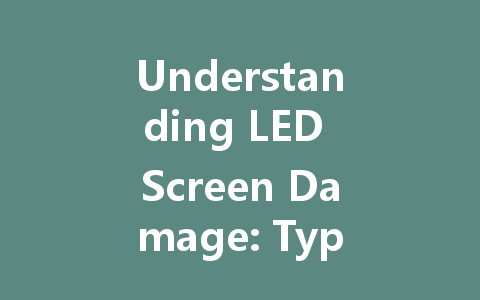
LED screens have become a staple in our daily lives, providing vibrant visuals for everything from televisions and smartphones to digital billboards and signage. However, like any technology, they are not impervious to damage. Understanding the various types of LED screen damage and the available repair solutions can help you make informed decisions when faced with issues. In this article, we will explore the common types of LED screen damage, the causes, and the best repair strategies to restore your device to its optimal performance.
Common Types of LED Screen Damage
LED screens can suffer from a range of damages, each affecting their functionality and display quality differently. Here are some of the most common types:
One of the most visible types of damage is a crack on the surface of the LED screen. This damage often results from impacts, such as dropping the device or applying too much pressure. A cracked screen can lead to further complications, including internal damage and display issues.
Dead pixels occur when individual pixels on the LED screen cease to function. They might appear as small black dots or be stuck in one color, disrupting the visual experience. While a few dead pixels may be seemingly harmless, they can be frustrating and affect the overall quality of the display.
Color distortion can manifest in various ways, such as uneven coloring, banding, or overly saturated tones. This issue can be caused by faulty components within the display or effects of wear and tear. Color distortion might not be as visibly disruptive as cracks or dead pixels, but it can certainly impact clarity and enjoyment.
A flickering or flashing screen can be indicative of several underlying issues, such as a faulty power supply, loose connections, or hardware malfunctions. This type of damage can not only hinder viewing experiences but may also lead to further deterioration over time.
LED screens utilize backlighting to illuminate displayed images. Problems with the backlight—whether it’s too bright, too dim, or completely nonfunctional—can result in reduced visibility and an inability to view content correctly. Backlight issues may stem from failures in components that support lighting.
Causes of LED Screen Damage
Understanding the root causes of LED screen damage is crucial for prevention as well as effective repair:
Repair Solutions for LED Screen Damage
Now that we’ve identified some common types of LED damage and their causes, let’s discuss potential repair solutions.
For cracks or shatters, the most effective solution is often a full screen replacement. While this can be costly, it ensures that the device returns to its original condition. Many manufacturers and repair shops offer this service, so it’s worth getting a quote before deciding.
In cases of dead pixels, there are software solutions designed to refresh pixel functionality. These tools cycle through colors on the affected pixels, potentially reviving them. Keep in mind that success rates can vary depending on the severity of the issue.
For issues related to color distortion or flickering, check if the screen requires calibration or software updates. Sometimes, outdated software can lead to display irregularities, which may be rectified with a simple update.
After identifying the nature of the problem, involving a professional service might be the best route, especially for complicated issues like backlight failures or significant internal damage. They can provide a detailed diagnosis and the necessary repairs.
If you are comfortable with technology and repairs, you might explore DIY options for simple fixes like resolving loose connections or minor software issues. However, it’s essential to weigh the risks—improper handling can lead to further damage.
Conclusion
LED screens are integral to our daily lives and experiences, making it essential to care for them properly. By understanding the types of screen damage, their causes, and available repair solutions, you can protect your display investment and enhance its longevity. Whether you choose to tackle minor issues yourself or call in professionals for more serious repairs, taking proactive measures will keep your LED screen delivering its best performance for years to come. Remember, when in doubt, consulting with a qualified technician is always a wise choice!